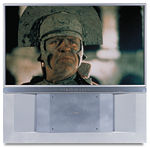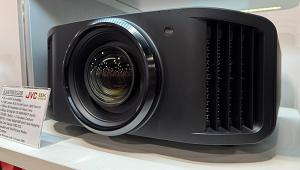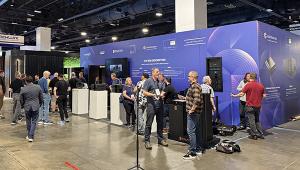Mitsubishi WD 6500 DLP Projection Television
Taking advantage of new technology is always a good thing. It's even better when the base technology has a proven track record. Mitsubishi has entered the DLP-projection marketplace with their WD 6500, a 16:9, high-definition rear-projection television.

This is very exciting for the consumer because it brings the long-established television into the digital age. Until recently, digital technology was reserved only for special engagements at premiere movie theaters. DLP brings a complete digital image to your eyes. Yes, the WD 6500 uses 1s and 0s to create the image on the screen. Not only that, but it accepts just about anything you might want to plug into it and converts the incoming signal to match the display's native resolution of 720p. Recently, I took a look at a preproduction sample of this TV at Mitsubishi's headquarters.
The WD 6500 has a large cabinet with a large screen, which makes for good viewing in a large room. This is the unit that videophiles have been waiting for. It accepts standard-definition television (SDTV), high-definition television (HDTV), and all external video sources, such as VCR, satellite, and either interlaced or progressive DVD. There are both component and RGB inputs to accommodate nearly any DTV receiver. The WD 6500 accepts 480i, 480p, 720p, and 1080i inputs and scans them onscreen in the display's native resolution—1,280:720.
 A nice bonus is that the display makes for a clean-looking computer monitor. Yes, with DLP technology, you can plug your computer's video card directly into the D-Sub 15-pin plug. The WD 6500 supports VGA, SVGA, or XGA at 60 hertz and produces a very large, clean, progressive computer image without motion artifacts. This allows you to surf the Web and watch your programming at the same time, although you can't show both on the screen simultaneously. You can pull up the Website of the program you're watching or even read your e-mail on a 65-inch monitor.
A nice bonus is that the display makes for a clean-looking computer monitor. Yes, with DLP technology, you can plug your computer's video card directly into the D-Sub 15-pin plug. The WD 6500 supports VGA, SVGA, or XGA at 60 hertz and produces a very large, clean, progressive computer image without motion artifacts. This allows you to surf the Web and watch your programming at the same time, although you can't show both on the screen simultaneously. You can pull up the Website of the program you're watching or even read your e-mail on a 65-inch monitor.
At the heart of this unit is the 1,280- by 720-pixel DLP chip. Digital Light Processing technology is a revolutionary way to project and display information. Based on the Digital Micromirror Device (DMD) developed by Texas Instruments, DLP is the final link in displaying digital information, and it has several advantages over existing projection technologies. For one, the digital nature of DLP enables precise image quality with digital gray scale and color reproduction. Also, there's no convergence or tube burn-in to be concerned with. Because they're analog devices, CRT displays drift with time. DLP displays don't. The only maintenance with a DLP projector is replacing the light bulb, which isn't unlike replacing the headlamp on your car.
The elements of a DLP projector are: the DLP chip itself, signal processing at the input to convert all signals to the DLP chip's native resolution, a light source, a color-filter system, a cooling system, and illumination and projection optics. You could describe a DMD as a semiconductor light switch. Thousands of tiny mirrors, fabricated on hinges atop a static random access memory (SRAM), make up a DMD. Each mirror is capable of switching one pixel of the 1,280:720 image. The hinges allow the mirrors to tilt between two states: +10 degrees for "on" and -10 degrees for "off." The square mirrors on a DMD are 16 micro-meters, separated by 1-micrometer gaps, giving a fill factor of up to 90 percent. In other words, 90 percent of the pixel/mirror area can actively reflect light to create a projected image.

This TV offers 10 inputs, including RF, S-video, component, RGBHV, and D-Sub 15-pin connections.
Since the DLP chip only accepts a digital signal, analog signals are converted to digital signals at the input. Any interlaced video signal is converted to progressive through interpolative processing. From here, the signal goes through video processing and becomes red, green, and blue (RGB) data. The progressive RGB data is then formatted into binary bit planes of data. Once the video or graphic signal is in a digital format, it is sent to the DMD. Each pixel of information is mapped directly to its own mirror in a 1:1 ratio, giving exact, digital control. If the signal is 640 by 480 pixels, the central 640-by-480 mirrors on the device would be active. The other mirrors outside of this area would simply be turned to the off position. Because of this, the video processor will upconvert the incoming signal to match the DLP IC's display resolution, filling the entire screen.
By electrically addressing the memory cell below each mirror with the binary-bit-plane signal, each mirror on the DMD array is electrostatically tilted to either the on or the off position. The technique that determines how long each mirror tilts in either direction is called pulsewidth modulation (PWM). The mirrors are capable of switching on and off more than 1,000 times per second. This rapid speed allows for digital gray scale and color reproduction.
At this point, DLP becomes a simple optical system. After passing through condensing optics and a color-filter system, the light from the projection lamp is directed at the DMD. When the mirrors are in the on position, they reflect light through the projection lens and onto the screen to form a digital, square-pixel projected image. Another digital advantage is DLP's accurate reproduction of gray scale and color levels. And, because each video or graphics frame is generated by a digital, 8- to 10-bits-per-color gray scale, the exact digital picture can be re-created again and again. For example, an
- Log in or register to post comments



























































